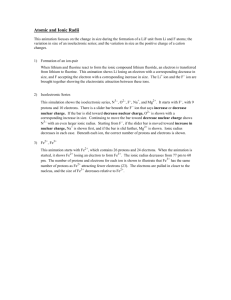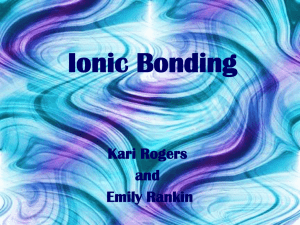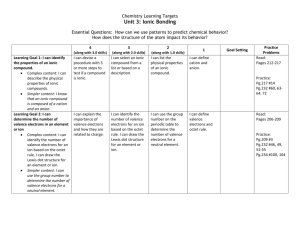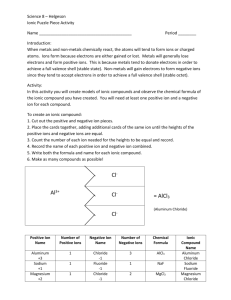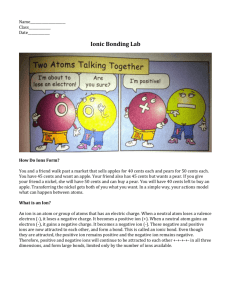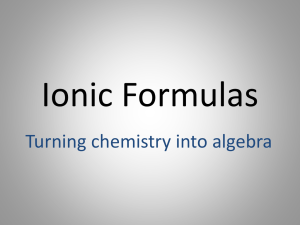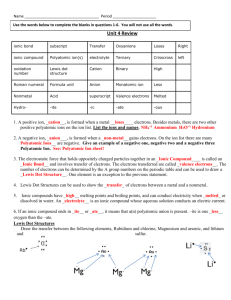Ionic & Metallic Bonding Review: Chemistry
advertisement
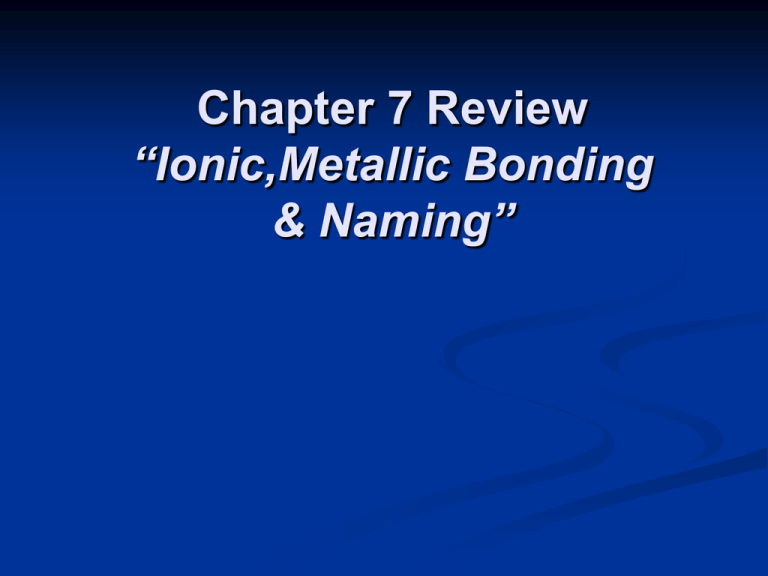
Chapter 7 Review “Ionic,Metallic Bonding & Naming” Chapter 7 Review What does the term coordination number in ionic crystals refer to? How many electrons does nitrogen gain in order to achieve a noble-gas electron configuration? Which of the following compounds contains the Mn3+ ion: a) MnS, or b) Mn2O3? Chapter 7 Review How many valence electrons are in an atom of magnesium? What is the electron configuration of the calcium ion? What is the formula of the ion formed when cadmium achieves a pseudo-noble-gas electron configuration? Chapter 7 Review Ionic compounds are normally in which physical state at room temperature? What sub-atomic particle is free to drift in metals? What is the formula of the ion formed when potassium achieves the noble-gas electron configuration? Chapter 7 Review What is the formula of the ion formed when phosphorus achieves a noble-gas electron configuration? What is the charge on the strontium ion? Know the characteristics of an ionic compound. A compound held together by ionic bonds is called a ____. Chapter 7 Review What is the formula of sodium nitride? What is the name given to the electrons in the highest occupied energy level of an atom? What is the basis of a metallic bond? What is the name for Sn3(PO4)2? Chapter 7 Review Which of the following elements does NOT form an ion with a charge of 1+: a) fluorine, or b) potassium? How many valence electrons are in an atom of phosphorus? Which of the following represents an ionic compound: a) BaI2, or b) PCl3? Chapter 7 Review Under what conditions can potassium bromide conduct electricity? What is the electron configuration of the iodide ion? When Group 2A elements form ions, they ____. Chapter 7 Review What is the electron configuration of the gallium ion? What characteristic of metals makes them good electrical conductors? When naming a transition metal ion that can have more than one common ionic charge, the numerical value of the charge is indicated by a ____. Chapter 7 Review An ionic bond is a bond between ___. In which of the following are the symbol and name for the ion given correctly: a) OH1-: hydroxide; O2-: oxide, or b) PO33-: phosphate; PO43-: phosphite? Chapter 7 Review Which of the following pairs of elements is most likely to form an ionic compound: a) magnesium and fluorine, or b) sodium and aluminum? What occurs in an ionic bond? What is true about the melting temperature of potassium chloride? Aluminum is a Group 3A metal. Which ion does Al typically form: a) Al3-, or b) Al3+? Chapter 7 Review How many valence electrons are in a silicon atom? What is the formula for potassium sulfide? How many electrons does barium have to give up to achieve a noblegas electron configuration? What is the formula of aluminum oxide? (a formula unit) Chapter 7 Review What is the net charge of the ionic compound calcium fluoride? The octet rule states that, in chemical compounds, atoms tend to have _____. What is the charge on the cation in CuSO4? Chapter 7 Review How many valence electrons are in bromine? Permanganate Phosphate Carbonate Nitrate Perchlorate Cyanide Sulfate Chlorite Hydroxide Chromate

